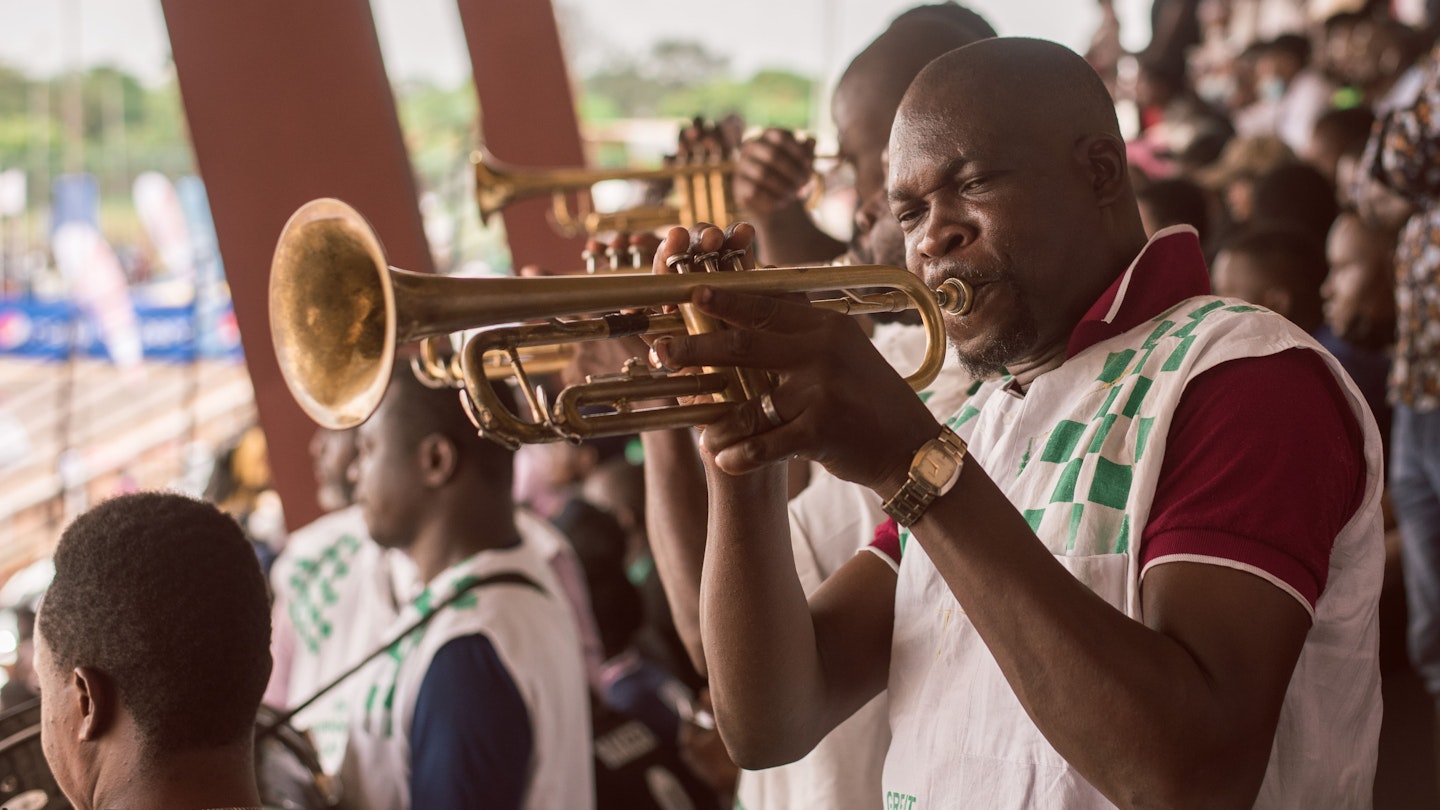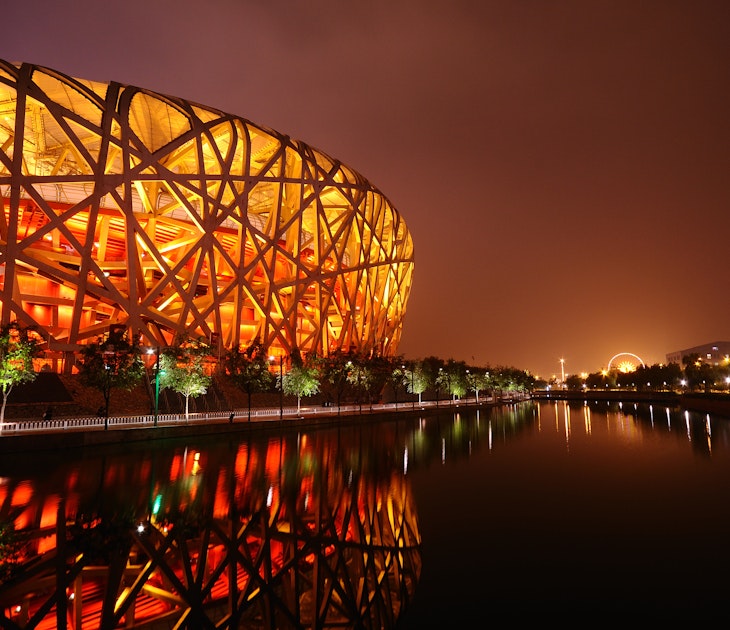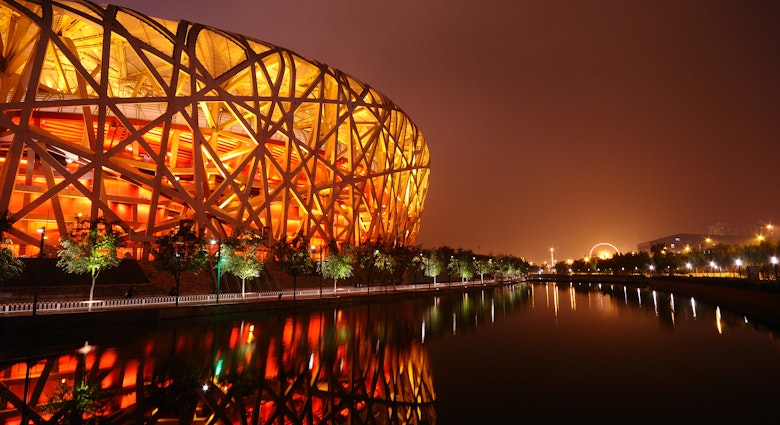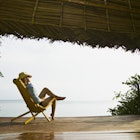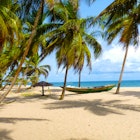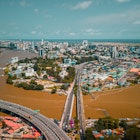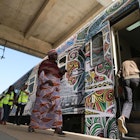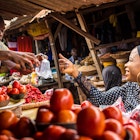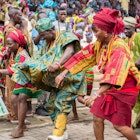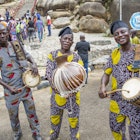There is so much for visitors to Lagos to enjoy – depending on the area, you can tour its heritage sites, some dating back 500 years, or taste the cosmopolitan flavors of Nigeria’s food culture. With a 186km (116-mile) coastline sprinkled with beach resorts, it's also got no shortage of places to stretch out in the sunshine and forget your worries.
Once you've shaken off the stress of home and you’re in the mood for some song and dance, Lagosians will proudly tell you there’s no party like a Lagos party. Whenever you're planning to visit, these are some of the best neighborhoods to check out when you arrive.
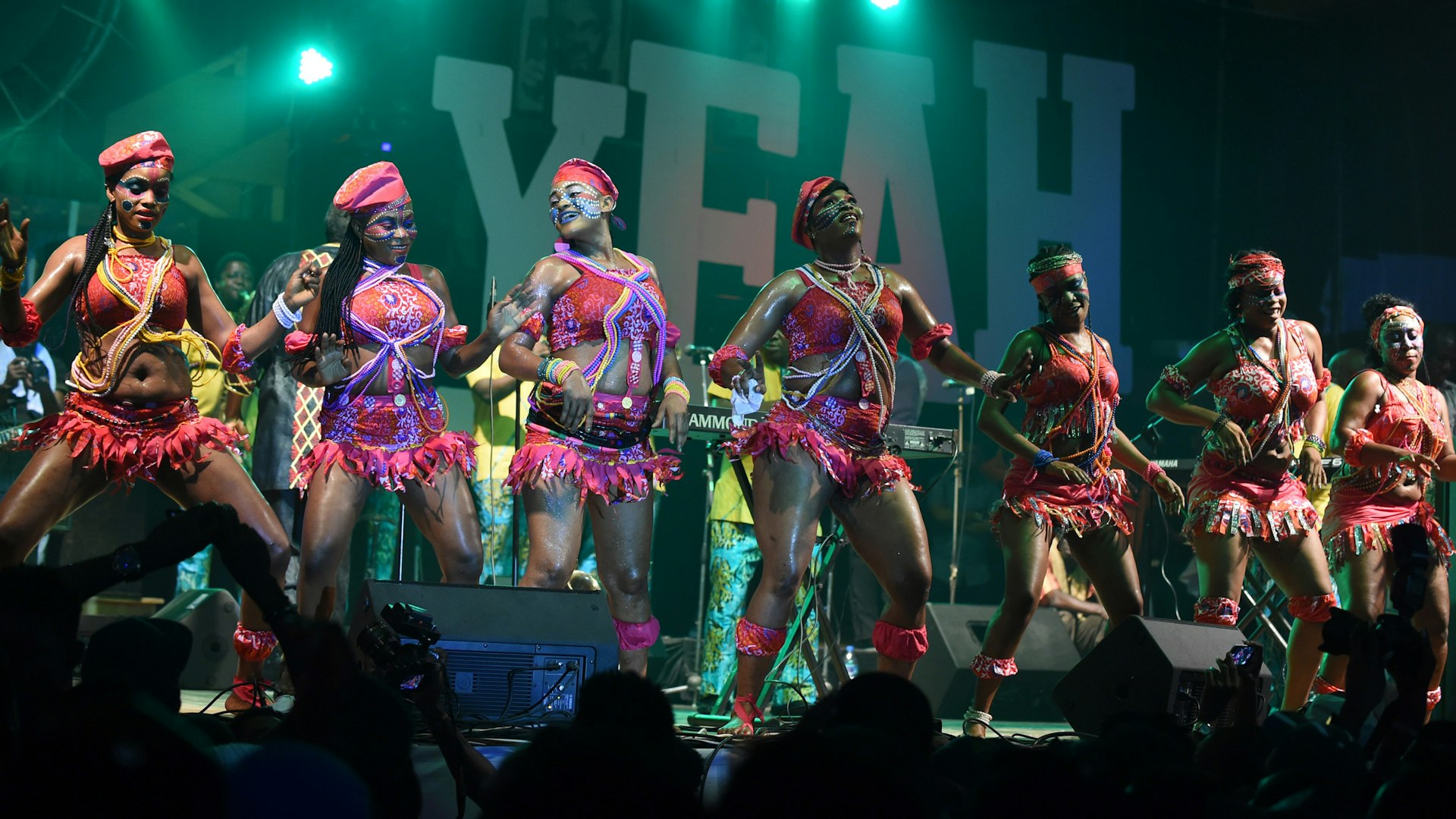
Groove to Afrobeats in Ikeja
Lagos is the birthplace of Afrobeats, a genre of music pioneered in the 1970s by the late Fela Kuti. If you’re a fan, nothing could feel more right than dropping in at his former home, now the Kalakuta Republic Museum in Ikeja.
From the ground floor up, dozens of family portraits line the walls. The tour ends at a terrace bar backdropped by an oil painting of the musician – the default spot for selfies. Order jollof rice, chips and drinks and listen to a continuous stream of Fela’s music, or stay longer by booking one of the five rooms in the second-floor boutique hotel.
If you'd rather bed in at another hotel in the neighborhood, Treasureland Cottage and Presken Hotel are excellent for budget travelers. For a little more luxury, consider the recently opened Watercress Hotels on Oritshe Street, off Awolowo Way.
From there, head to the New Afrika Shrine, built by Fela’s multiple-Grammy-nominee son Femi, who rehearses on Thursday evenings for free and performs to a packed hall during the Shrine’s main show, Sunday Jump.
The Shrine is about the size of a soccer pitch and is open throughout the week. Its core patrons are young Lagosians who come to play snooker, chat over drinks and watch soccer matches. However, the place is at its liveliest in mid-October during Felabration, the weeklong series of concerts to mark Fela’s birthday, when local and international musicians thrill thousands of fans. Sit on the ground floor, or enjoy the performances from higher up at the back of the hall in the VIP/VVIP sections.
At this time, the air is smoke-heavy and shows stretch well into the small hours, so consider lodging within the Agidingbi area. Pearlwort Hotel and Suites and De Meros Hotel & Suites – both three-star hotels – are a 10-minute walk away.
Chill at a park in Alausa
Still in Ikeja, Alausa is the administrative heart of Lagos, but also one of its more ambient locales. Its wide, tree-lined sidewalks – including Governor’s Rd, Governor’s Ave, Mobolaji Johnson Ave and the short stretch of the Obafemi Awolowo Way that runs past the state secretariat – make it one of the easiest neighborhoods to explore on foot.
Stop for a breather at the beautifully landscaped Johnson Jakande Tinubu (JJT) Park, adjoining the Lagos State House of Assembly complex. The park is a great place to spend a refreshing hour or two – it’s quieter on weekdays but packed with picnicking families on weekends, especially on Sundays.
Relax under a shaded tree, or sit in any of the half-dozen gazebos scattered about and watch everyday Lagos drift gently by. While there’s a general atmosphere of calm, familiar sights include students on excursions, celebrants marking their birthdays, couples posing for pre-wedding shoots and small teams recording low-budget music videos.

Walk down memory lane, from Onikan to Broad Street
As the hub of British colonial rule from the late 19th century until Nigeria’s independence in 1960, the Onikan–Broad Street–Marina district on Lagos Island is perfect for walking tours.
It has some important historic sites from the years of colonial rule: the National Museum, Tafawa Balewa Square (formerly a race course and the venue for Nigeria’s Independence ceremony), Holy Cross Cathedral (Catholic), Lagos City Hall, St George’s Hall, Government Printing Press, CBAAC Building (houses the FESTAC museum and a library), Old Government House and secretariat and the Christ Church Cathedral (Anglican).
Take a break and stop over at Freedom Park, enclosed within a 200-year-old fence. Previously a 19th-century prison, it’s now a garden, arts center, gallery, bar, restaurant and museum, all rolled into one; with seating areas scattered throughout, you can choose any part of the leafy surroundings to chill in. The fountain and fish-and-duck pond add to the overall calming ambiance of the place.
Get a sense of the prison’s dreadful past on a walk through some of its repurposed landmarks: a block of cells is now an exhibition and reading space; the records office, a museum/gallery/office space; the European prisoners' cell block, an amphitheater; and the gallows, a performance stage.
While at this, you’ll come across more than a dozen sculptural pieces celebrating some of Nigeria’s cherished traditions and the remarkable industry of everyday Nigerians. The food court (formerly the prison’s kitchen) is a fine place to try out some of the mouth-watering local dishes: jollof rice, fish pepper soup, pounded yam and vegetables.
Explore the city’s Brazilian ties
In addition to the colonial-era buildings on Lagos Island, the character of Lagos' cityscape is shaped by 19th-century Brazilian-style architecture. After Afro-Brazilians liberated from enslavement sailed back to West Africa en masse from the 1850s onwards, thousands were allocated land in the Popo Aguda area – aka the Brazilian Quarter.
Onikan House is a fine specimen that has been restored by a private concern. Built in 1940, it is a repository of photographs, maps and charts showing the people and events that shaped Lagos, from its earliest incarnation in the mid-15th century as a sparsely populated commune to its present as a megacity of more than 20 million residents. Highlights include the Eyo room on the first floor and a cute little library in the attic.
You may pre-book an in-house tour, which will take you in a danfo (mini-bus painted in the yellow-and-black, the official color of commercial transport in Lagos) and stop at some of the important heritage sites on Lagos Island, including the Afro-Brazilian Cultural Center. It is where surviving descendants of the returnees have made a modest attempt to preserve the memory of their forebears.
Mingle with royalty in Downtown Lagos
Lagos may be a cosmopolitan city, but it is also a deeply traditional society. Isale Eko (Downtown Lagos) was first settled by Awori fishermen and farmers in the 15th century, and it is here that the first royal family was installed in the 1630s. Iga Idugaran, the palace of the king of Lagos, was built in the early 18th century; the settlement that has grown around it since then is a labyrinth of densely packed multi-story apartment blocks, shrines, palaces and mini recreation centers, so your best bet is to explore on foot.
Until recently, you could walk into the spacious forecourt of the king’s palace and marvel at not only its architecture and wide ornamental double doors but also cannon guns from the 1850s shelling of the neighborhood by anti-enslavement British naval regiments in the 1850s. Nowadays, it’s fenced off from view, and entry is restricted.
But not to worry, there are plenty more slices of history and heritage lurking at almost every turn because there are more palaces (locally called Igas) here per square mile than any other locale in the city. Traditionally, Lagos is administered by 69 white-cap chiefs in four different classes: the Akarigberes (royal chiefs), Idejos (land owners), Ogalades (spirituals), and Abagbons (war chiefs). All of them operate under the leadership of the Oba of Lagos.
Key landmarks worth visiting include the palace of Eletu Odibo, the traditional prime minister; Enu Owa, the shrine at the head of the street, and where every king of Lagos is crowned in a weeklong ceremony; Awe Adimu, enclave of the custodian of the Eyo Festival cult, the highly esteemed cultural identity of Lagos; and Erelu Square, site of the tomb of Erelu Kuti, whose lineage has produced every king ever crowned from the 1740s. If you still have wind in your sails, add the Elegba shrine, Oju Olobun Shrine and Obun Eko, the oldest known market in metropolitan Lagos.
The Isale-Eko House, situated opposite the Iga Iduganran palace, will help facilitate a walking tour of the area if notified in advance.
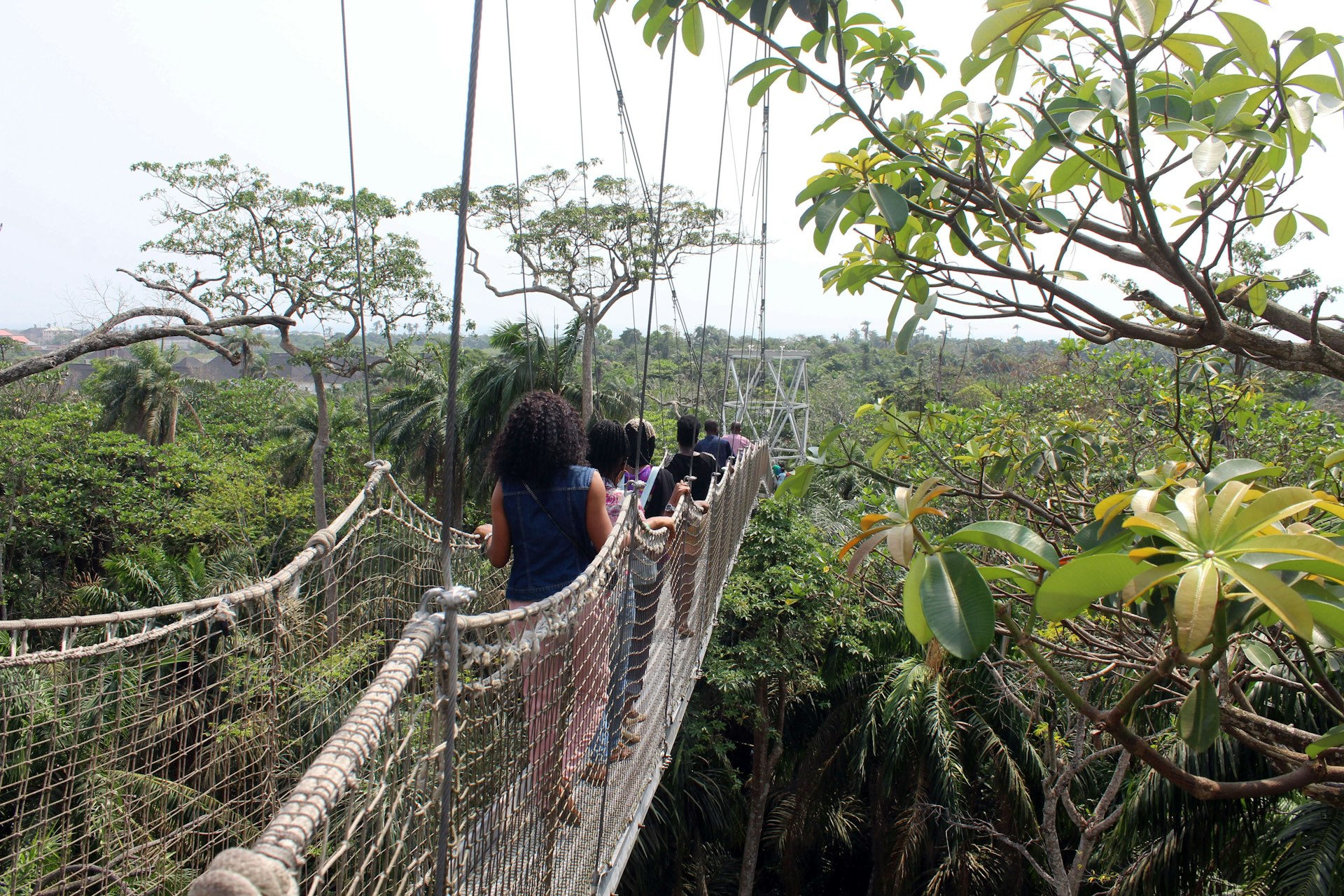
Go bird-watching in Lekki
Lekki is the preferred home for rich and famous Lagosians, with multimillion-dollar real-estate developments continuing to spring up. It’s got the trendiest restaurants and bars and an ever-increasing collection of galleries.
If you’re looking to escape the fast-paced tempo of everyday Lagos, visit the Lekki Conservation Center, a 75-hectare (185-acre) patch of unspoiled mangrove. The park’s ubiquitous mona monkeys are noticeable right from the gates and you can get up close to them on the boardwalk. But the highlight of a visit here is walking above the forest on the 401m (1315-ft) canopy walkway. It’s a busy spot for the bird-watching community and other attractions include fish ponds, life-size board games and multiple gazebos scattered across the savanna-type vegetation.
There’s also Lufasi Park, a wildlife sanctuary on 25 hectares (62 acres) of preserved habitat, a 10-minute drive away on the Lekki-Epe Expressway. Managed as a public-private partnership, its chief attractions are Nora lake, a fern and butterfly garden and a plant nursery, as well as a spot for forest bathing by an ironwood tree. On the way to Epe, don’t miss the architectural masterpiece that’s the Yemisi Shyllon Museum, Pan-Atlantic University's art museum and one of the most delightful landmarks in the city.
Explore Badagry’s history of enslavement
Badagry is the crown jewel of Lagos tourism. Situated on the western tip of the state and boasting the most listed heritage sites statewide, it is the most-visited destination for both local and international tourists, all of whom are drawn by its past as a port for the trafficking of enslaved people.
A typical day tour includes stops at Badagry Heritage Museum, the Brazilian Barracoon, Vlekete Slave Market and Mobee Slave Relics Museum, finished with a slow-paced 2.5km-walk (1.6-mile) along the route taken by enslaved people on famed Gberefu Island to the Point of No Return. Locals visit Badagry for its beaches, African Americans go there to connect with their ancestral origins and South Americans take the trip to explore the shrines, for which Badagry is also famous.
Badagry is a two-hour drive away from Ikeja, the capital, but the most fun and enjoyable way to get there is via the lagoon waters. Book a Lagos ferry ride from Five Cowries Terminal, or from the privately managed Tarzan, which has operated from its jetty on the island for more than two decades. The journey lasts about 90 minutes and offers the most scenic views of the state’s mangrove vegetation.
If you’re visiting as a group, local guides can arrange for you to be met by an Indigenous troupe, who will cheerfully welcome and serenade you with dance-inducing Badagry folk songs.
Badagry is okay to visit any time of the year, but best in August during the annual heritage festival, when it celebrates its pantheon of deities (Vothun and Zangbeto, among them) and diverse traditions. An evening is set aside for the Fitila procession, a reenactment of slave-raiding scenarios in memory of the millions of people taken from these shores during the trans-Atlantic trade of enslaved people.

